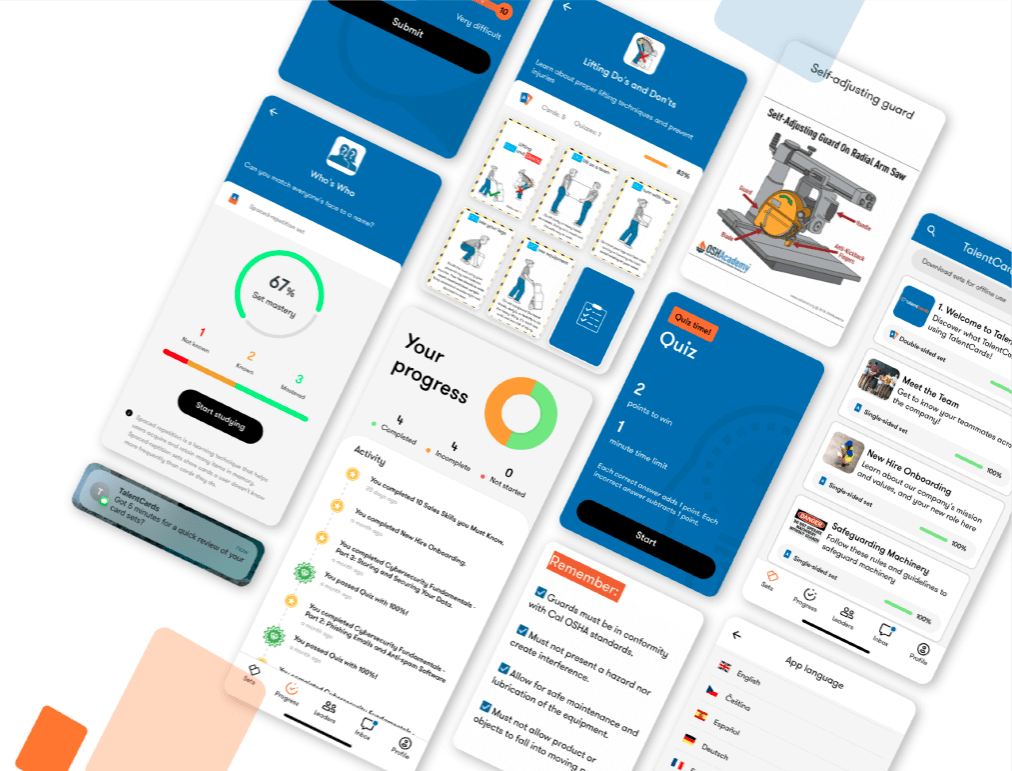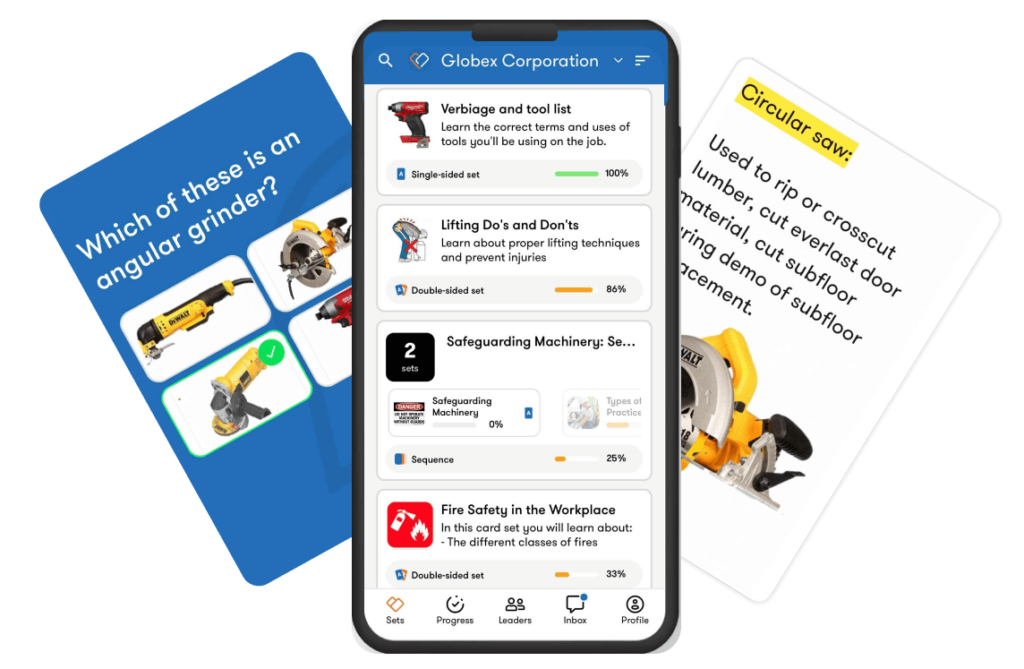In our fast-paced, technology-driven world, the demand for efficient and accessible learning has never been greater. Enter mobile training solutions: a dynamic approach to learning that leverages the power of smartphones and tablets to deliver training right into the hands of employees, wherever they are.
This method aligns with our increasingly digital lifestyles and addresses the need for continuous, on-the-go professional development. As we navigate an era where information is at our fingertips, mobile training stands out as a crucial tool, ensuring that learning never stops, even in the busiest schedules.
The evolution of training— from traditional to mobile
It’s projected that in 2024, mobile devices will account for 56% of worldwide internet traffic, overshadowing desktops, which are expected to generate 39%. With those stats in mind, it’s no wonder that training methods are changing.
In the past, traditional training in business meant coordinating multiple schedules, accounting for time away from the job, booking trainers, and meeting in a physical location. In other words, high cost events that took a significant amount of time.
Times have changed, however, and the rise in mobile device use has increased the popularity of training on the go.
By definition, mobile training is any learning or training accessed from a mobile device. But ideally, mobile training is training that is designed from the get go to be consumed on a mobile device. This training can be delivered through videos, podcasts, images, text, digital flashcards, and microlearning courses.
It’s obvious that by nature traditional training methods and mobile training solutions differ in many ways. Here are some key differences:
Traditional training methods
- In-person leadership: Anchored in physical locations like classrooms or training centers, this method relies on a live instructor to teach the material.
- Set in stone: Location and time are set and are not easily changed.
- Rigid scheduling: Its structure often clashes with individual schedules, sometimes requiring time away from work.
- Direct engagement: Offers the advantage of face-to-face interactions and instant feedback from the trainer.
- Contained resources: Access to training materials is generally restricted to the training setting itself or physical materials the learner must keep track of.
Mobile training
- Location and time flexibility: With materials accessible on mobile platforms, training can happen anytime, anywhere.
- Personalized pace: It affords learners the luxury of consuming content conveniently, minimizing disruptions to their work life.
- Diverse media: Leverages a mix of videos, games, and interactive sessions to engage learners.
- Virtual teamwork: Though not face-to-face, it facilitates online discussions and collaborative learning.
- Instant updates: Enables swift updates and dissemination of content to keep pace with new developments.
While traditional training frameworks provide the value of direct interaction and a structured learning environment, mobile training breaks barriers with adaptability, easy access, and innovative tools.
5 key benefits of mobile training solutions
While the benefits of mobile training are many and will be different for each industry, here are some of the top advantages of mobile training in business.
1. Flexibility and accessibility
Mobile training solutions allow employees to engage with learning resources at their convenience from any location. In a survey of 600 employees, 41% stated that training would be more enjoyable if they could complete it at their own pace. This self-paced learning environment aids in reducing cognitive overload.
2. Engaging content formats
By integrating interactive elements like videos, podcasts, and gamified experiences, mobile training boosts learner experience. And smartphones are exactly the place where people expect to find a gamified experience.
3. On-demand availability
When asked where they prefer to complete training, 78% of employees selected, right on the job. By having a mobile training solution in place, employees can enhance their skills and gain clarification on the spot. Learning resources are on-demand, 24/7, meaning there’s never a delay in order to find a supervisor, or reference a manual..
4. Cost efficiency
Mobile training presents a more economic option than traditional training methods. Physical training spaces, teachers, and printed materials are eliminated.
5. Adaptability
Mobile training swiftly addresses the need for new skills and knowledge. As soon as you have new training content or updates you need to push out to employees, you can easily do so with the right mobile training platform in place. All it takes is sending out a push notification to your employees and teams.
Mobile training enriches the learning experience for employees. It drives skill enhancement and improves business outcomes through its accessible, engaging, and flexible nature.
5 real-world mobile training solutions examples
Mobile training solutions lend themselves to industries with staff on the go. Deskless workers now make up 80% of the global workforce. Finding ways to reach this important group while in the field or on the go matters. Here are some of the industries that have benefited from transitioning to mobile training.
1. Manufacturing
Safety comes before anything else in the manufacturing sector. Mobile learning focuses on enhancing safety by delivering daily training directly to mobile devices. This method employs spaced repetition for improved knowledge retention, and stands out as a cost-effective and efficient alternative to printing paper manuals and other conventional methods.
Staying current on compliance needs, tracking progress in real time, and utilizing microlearning will keep the training engaging and relevant. Keep your field-based safe by offering flexible learning that fits into their busy schedules without disrupting work.
2. Food and beverage
In the food and beverage industry, mobile training focuses on food safety and hygiene. This training ensures that staff, such as restaurant workers and delivery personnel, adhere to essential safety standards.
Mastery of these topics is crucial for consumer health, compliance with health regulations, and maintaining the integrity and efficiency of food service operations. Mobile training provides a flexible, accessible means of ensuring these critical standards are met consistently across the industry.
3. Software and tech
Mobile training for the tech industry centers on ensuring their people are up-to-date with the latest skills. This is crucial in an industry that evolves rapidly, making continuous learning essential for staying on top of trends.
Microlearning courses help maintain product knowledge and technological advancements. This approach ensures that tech employees can learn and refresh their knowledge without interrupting their work schedules. Being able to adapt to the fast-paced nature of the tech industry is what matters most.
4. Healthcare
The healthcare industry has a distinct need for mobile training solutions. Areas like COVID-19 protocols, medical training for healthcare assistants, and soft skills for medical staff are always needed. A microlearning approach breaks down complex topics into manageable content, facilitating on-the-go learning for busy healthcare professionals.
This method enhances compliance training, reinforces key concepts, and is especially useful for deskless workers, ensuring continuous, accessible training without interrupting patient care.
5. Retail
Finding the balance between training and keeping staff on the sales floor is one of the many benefits mobile training offers the retail industry. It offers cost-effective training solutions for seasonal staff, ensures all retail associates are knowledgeable about product lines, and supports on-the-go learning. The mobile training approach allows for training before shifts or during breaks, minimizing disruptions and maintaining customer service quality.
Future trends in mobile training solutions
The landscape of mobile training is getting a major upgrade with AI, which tailors learning to fit each person’s needs perfectly.
Augmented Reality and Virtual Reality (VR) are turning training into an interactive adventure, making it easier to pick up complex skills.
Then there’s microlearning, which keeps things short and sweet, perfect for learning on the fly. These trends are all about making learning more personal, engaging, and fitting neatly into our busy lives.
Build your comprehensive mobile training program for free

FAQs
What is a mobile training program?
A mobile training program is a flexible, distance learning approach that allows users to access educational content on devices like smartphones and tablets anytime and anywhere.
These programs offer a mix of live sessions, compliance training, simulations, and microlearning apps, reaching diverse types of learners. Ideal for industries with decentralized workforces, such as manufacturing and healthcare, mobile training ensures consistent, accessible learning opportunities across locations. The emphasis is on convenience, engagement, and 24/7 availability.
What are training solutions?
Training solutions are the diverse methods and strategies used to provide educational content to individuals or organizations. These methods range from traditional instructor-led sessions to e-learning, mobile training, simulations, and various interactive learning formats.
The goal is to meet specific learning needs and goals through learning and development. Choosing the right training solution requires a thoughtful training needs analysis to determine goals, target audience, and available resources.
Mobile training platforms are the future of learning and development
As learning and development evolves, mobile training solutions like TalentCards are leading the charge in transforming how to approach education in business.
A custom mobile training solution not only meets today’s learners’ diverse needs, but also anticipates tomorrow’s demands. A more personalized and engaging learning experience comes with embracing an innovative platform. This perfectly aligns with the evolving landscape of training and education.
Key takeaways
- Mobile training solutions offer the flexibility of time and location in learning.
- Mobile training significantly enhances learner engagement and motivation.
- By eliminating the need for physical spaces and materials, mobile training presents a money-saving alternative to traditional training methods, reducing time and costs.
- From manufacturing to healthcare, mobile training solutions are proving to be effective in meeting the unique needs of various sectors.
- High-quality mobile training platforms provide custom mobile training solutions.
Explore the most powerful mobile training solution on the market



